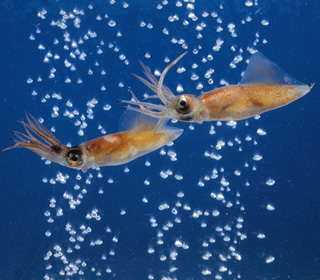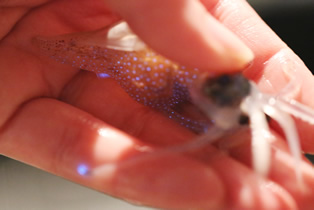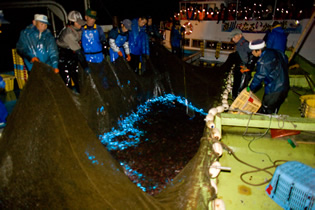What is Firefly Squid?

Firefly Squid
| Scientific Name | Watacenia sintillans |
|---|---|
| English Name | Firefly Squid |
Firefly Squid is mysterious creature shrouded in many riddles emitting pale light from the whole body. Spawned in spring ending its year-long life. Distributed the waters around this country centering in the Japan Sea and normally in the deep sea as deep as 200 to 600 meters.
Assemble near the beaches of Toyama Bay when spring comes around. Lights emitted to the ocean surface by firefly squid are beautiful as gem stones.
Origin of name of firefly squid
God Father is “Doctor of Firefly Squid”
In the old times, firefly squid is used to be called “matsuia”. In 1835, Doctor Shozaburo Watase named the species as “firefly squid”. When the doctor was investigating where the species lives, he heard there lives squid emitting lights in Toyama Prefecture and started studying and named the species as 「firefly squid」as it emits beautiful lights as fireflies.
Thereafter it was “Watacenia sintillans” in honor of the doctor’s name.
Emission of Firefly Squid

Mysterious “Cool Lights” which are very bright but not warm
Emission from firefly squid occurs from activation of light emission substance and light emission enzyme.
The emission is called as 「cool lights」since the lights do not emit heat.
The emission occurs in the same mechanism as that of fire flies or insects, but the structure of emitting substances and enzymes are somewhat different.
Three Causes of Emitting Lights
| Protect Itself by Lights | Arm lights-emitter emits lights by stimulation and/or astonishing enemies when attacked by an enemy in the dark ocean said to be aiming at one of dazzling effects. |
|---|---|
| Hiding by Emitting Lights | Firefly squid keeps its body horizontal and in the day time emits lights from emitter in belly side in response of the Sun light. It becomes conspicuous when the lights are too strong and becomes easier to be detected by an enemy by being a silhouette. In a sense, it is considered to protect itself from an enemy handsomely utilizing the light. |
| Converse by Lights | Squids and the like with a lights emitter have subtle difference as to number, arrangement, type and combination. It is considered that firefly squid is able to differentiate three colors of green, water and green and send signals among males and females and conduct in group. |
History of Sightseeing of Namerikawa and Firefly Squid
| 1585 | The relationship of firefly squid is old and the catch was already documented circa 1585. |
|---|---|
| 1912 | Sightseeing business was recommended in 1912 by the Governor of Toyama Prefecture and firefly squid sightseeing started. |
| 1961 | Circa 1963 three sightseeing boats sailed out in the evening sea and trial processing of fire squid-related started. |
| 1987 | Sightseeing by Namerikawa Sightseeing Association were become early morning ocean cruise method of today. |
| 1989 | Land-based sightseeing also started by Fishermen Center in 1989. |
| 1996 | Firefly squid was designated as Fish of Toyama Prefecture in 1998. |
| 1998 | The Museum of Firefly Squid was completed. |
Cause of flocking Firefly Squid to Toyama Bay

Sighting of large school of firefly squid is limited to Toyama Bay near Namerikawa.
They live in the deep sea as deep as 200 to 400 meters deep in the deep sea in day time and surface near the land for spawning.
Sighting of schools of firefly squid is said to have relationship of grating bowl terrain and ocean current (upward current ascending from the bottom).
“The sea area of firefly squid, flocking together” is designated as the natural monument.
The longevity of firefly squid is almost one year. The necessary spawning time is about two weeks in Toyama Bay. It keeps growing and in February or so welcomes the mating season and spawns again in April or May ending its life.
The longevity of firefly squid is almost one year. The necessary spawning time is about two weeks in Toyama Bay. It keeps growing and in February or so welcomes the mating season and spawns again in April or May ending its life.